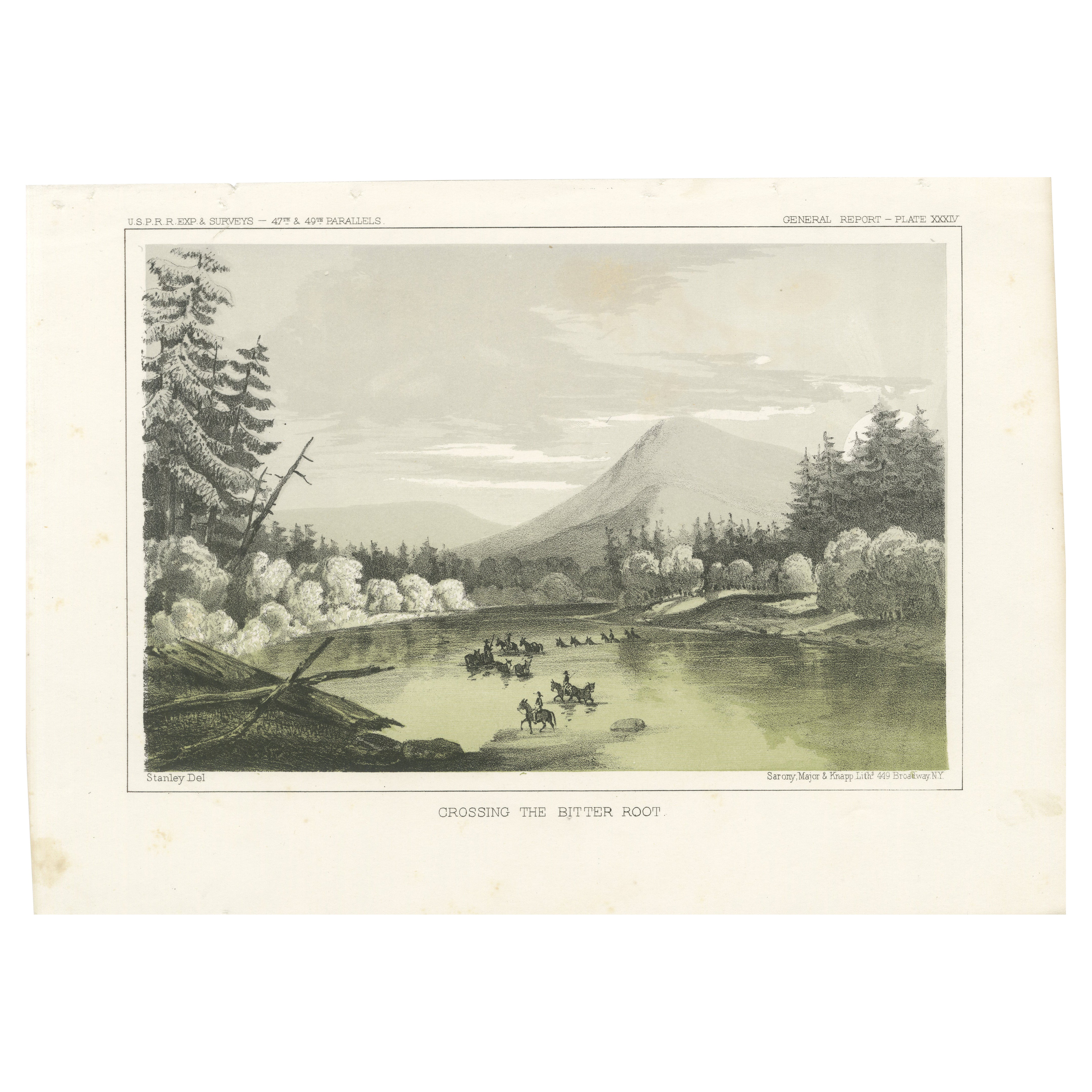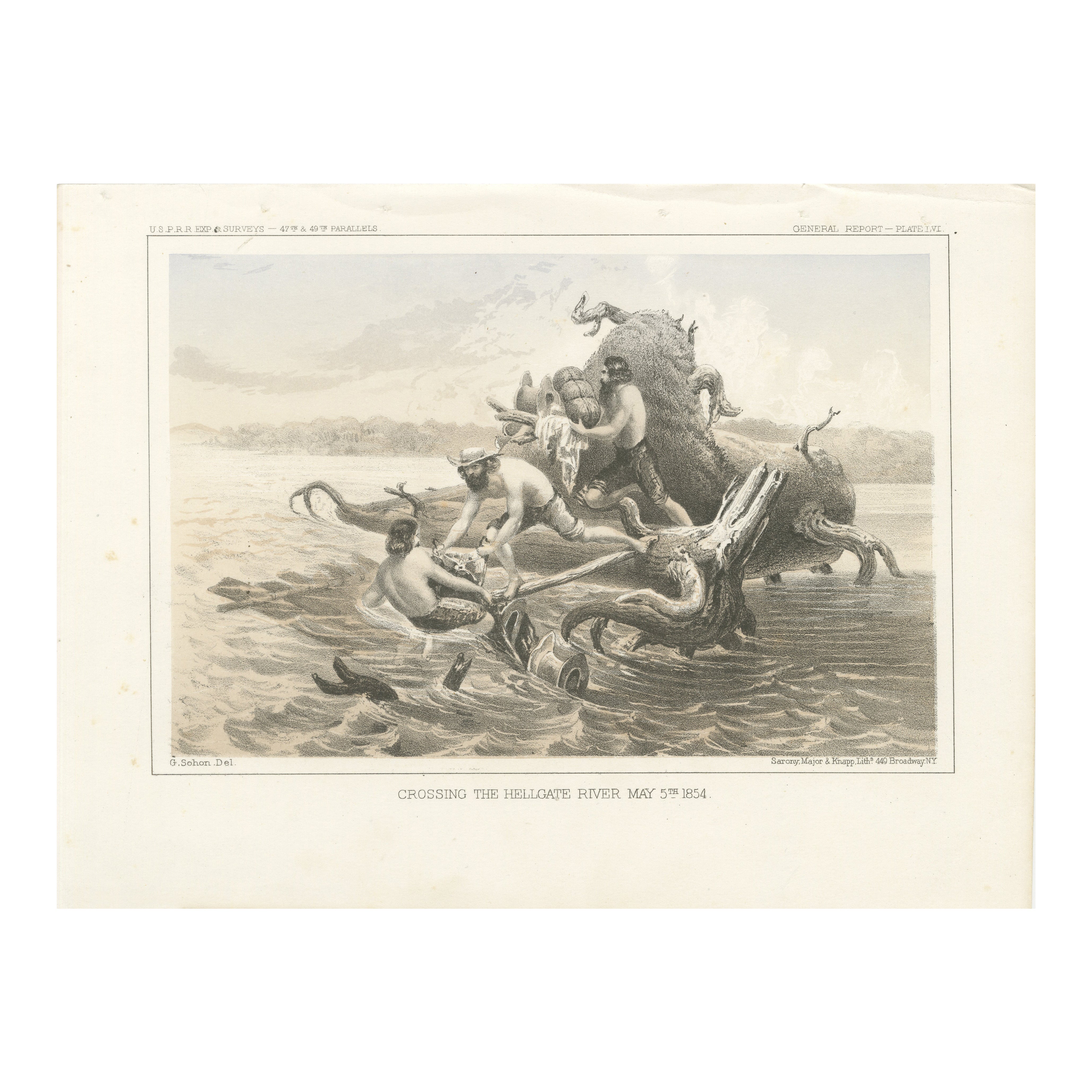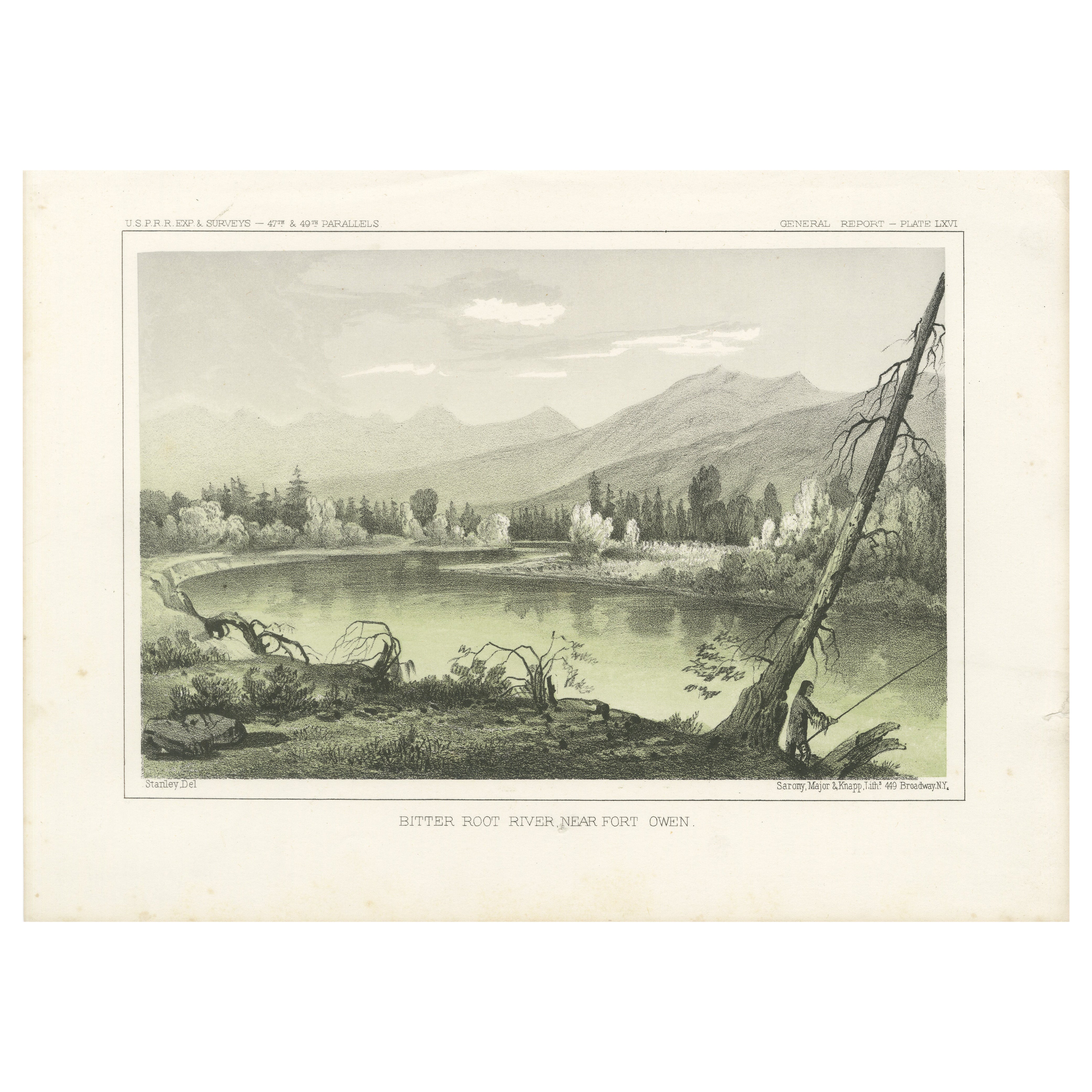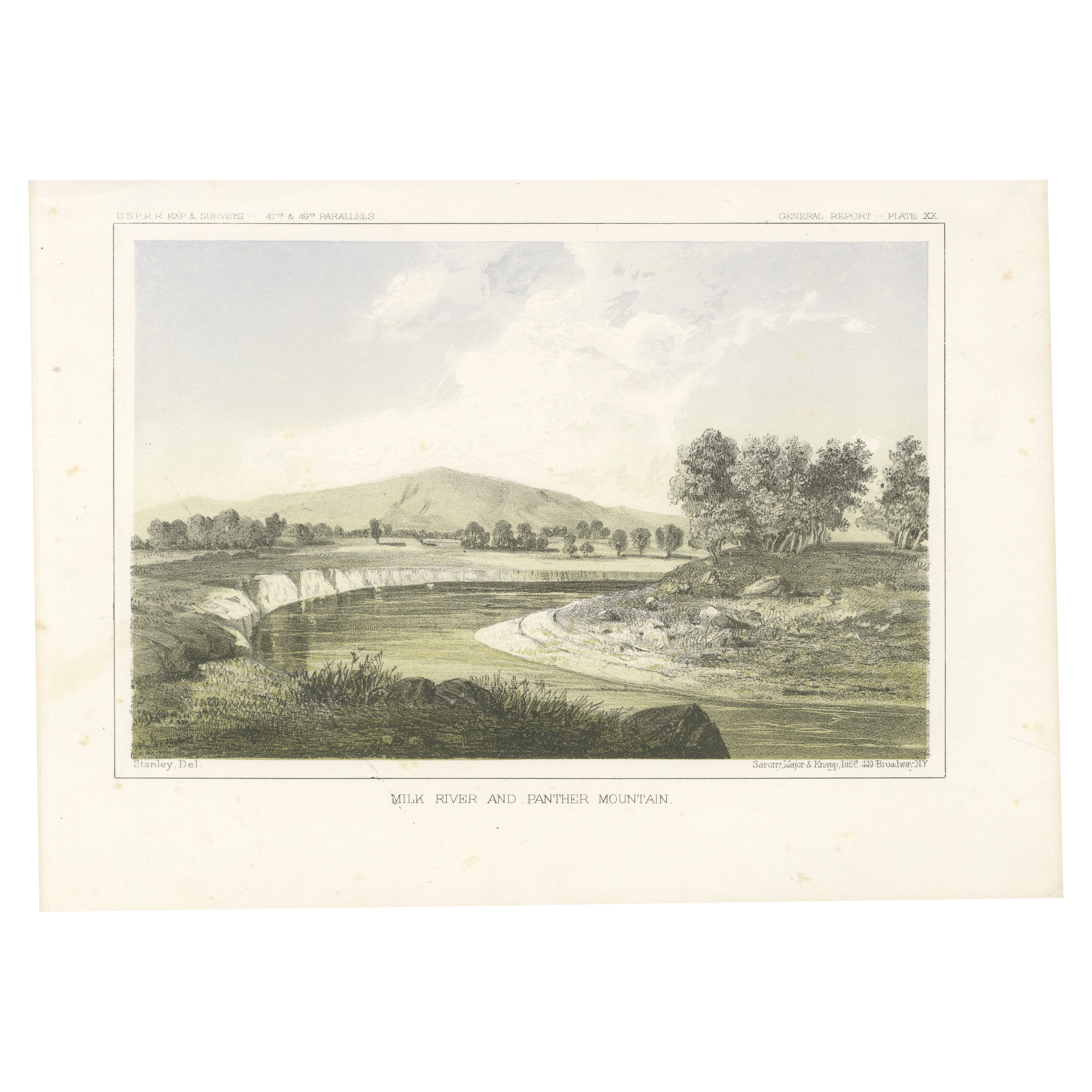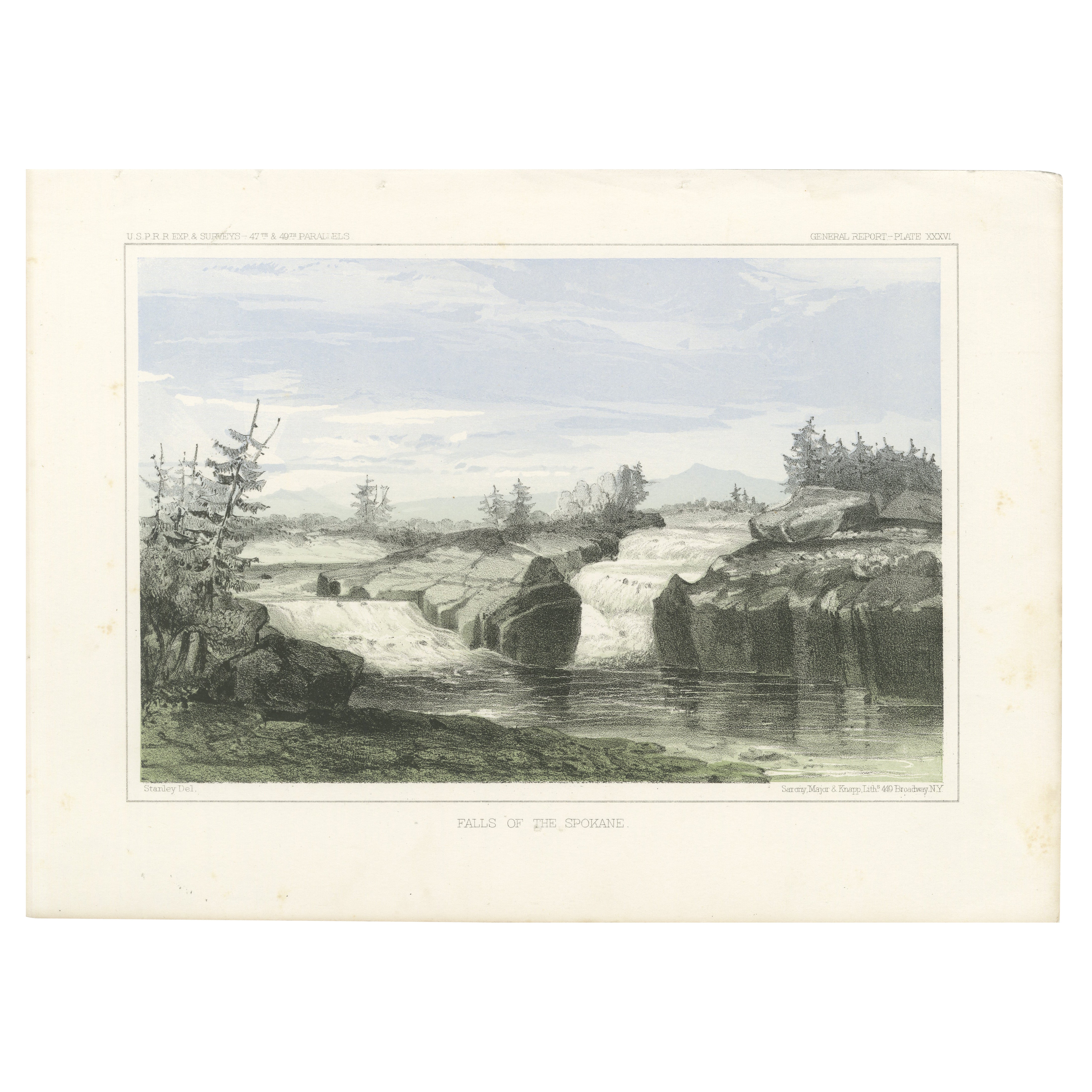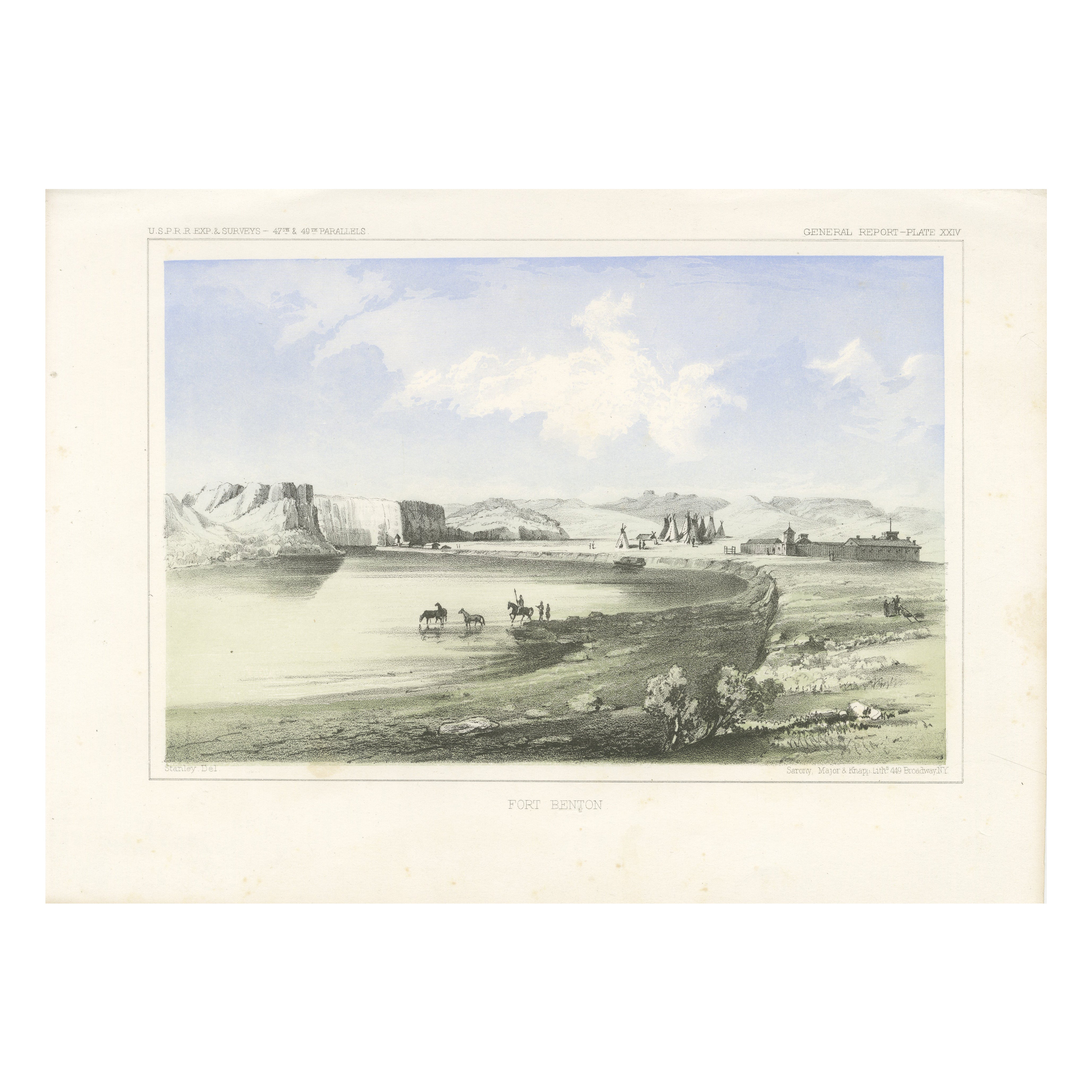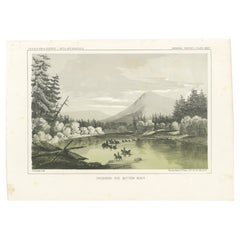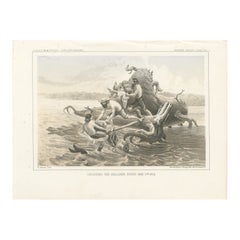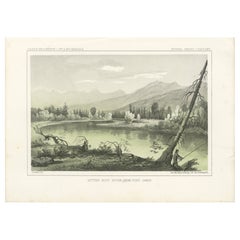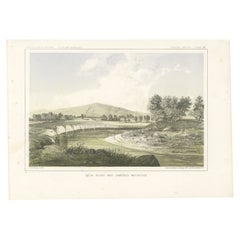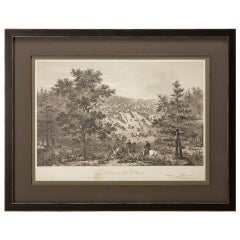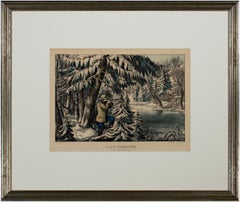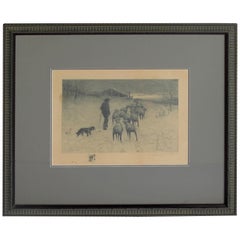Items Similar to Crossing the Hellgate River in Winter, Montana - Historic 19th-Century Litho
Want more images or videos?
Request additional images or videos from the seller
1 of 6
Crossing the Hellgate River in Winter, Montana - Historic 19th-Century Litho
$263.59
£196.19
€220
CA$361.05
A$401.57
CHF 209.69
MX$4,886.70
NOK 2,678.04
SEK 2,511.53
DKK 1,674.78
Shipping
Retrieving quote...The 1stDibs Promise:
Authenticity Guarantee,
Money-Back Guarantee,
24-Hour Cancellation
About the Item
Title: Crossing the Hellgate River, January 6th, 1854 - Historic Lithograph
Description: This lithograph, "Crossing the Hellgate River, January 6th, 1854," captures a moment of adventure and perseverance during mid-19th-century exploration in the American West. The scene depicts a group of travelers and their pack animals navigating the icy waters of the Hellgate River, surrounded by a winter landscape of barren trees and snow-covered terrain.
The artwork is part of the Pacific Railroad Survey reports, General Report – Plate LXV, published in 1856. Created by Gustavus Sohon, a skilled artist and explorer, and lithographed by Sarony, Major & Knapp, it vividly illustrates the challenges faced by survey teams as they sought to chart the best routes for the transcontinental railroad.
The composition balances human determination with the rugged beauty of nature. The frozen river, reflective and treacherous, dominates the center, while trees and scattered rocks add depth to the image. The detail in the horses, figures, and surrounding landscape is a testament to Sohon’s artistry and the precision of 19th-century lithographic techniques.
The Hellgate River is the historical name for what is now part of the Clark Fork River in western Montana. It flows through the Hellgate Canyon, just east of the city of Missoula. The river and canyon were named "Hellgate" by early French trappers due to the area's history of being a site of conflict between Native American tribes.
The Clark Fork River is a major waterway in Montana, known for its scenic beauty and significance in the region's history, including during the westward expansion and exploration of the United States. Hellgate Canyon remains a prominent feature near Missoula, often associated with the dramatic landscapes of the Rocky Mountains.
Condition: Very good, with light foxing on the margins. The image remains sharp and well-preserved, with no significant blemishes.
Framing Tip: Highlight the wintery tones with a white or light gray matte and a classic wooden frame. A simple, elegant presentation will emphasize the lithograph’s historical significance and artistic detail, making it a standout piece in any collection of Western Americana or exploration-themed art.
- Dimensions:Height: 8.15 in (20.7 cm)Width: 11.15 in (28.3 cm)Depth: 0.01 in (0.2 mm)
- Materials and Techniques:
- Period:
- Date of Manufacture:1856
- Condition:Condition: Very good, with minimal foxing at the margins. The image is crisp, and the colors remain vivid and well-preserved.
- Seller Location:Langweer, NL
- Reference Number:Seller: BG-14038-271stDibs: LU3054343477352
About the Seller
5.0
Recognized Seller
These prestigious sellers are industry leaders and represent the highest echelon for item quality and design.
Platinum Seller
Premium sellers with a 4.7+ rating and 24-hour response times
Established in 2009
1stDibs seller since 2017
2,502 sales on 1stDibs
Typical response time: <1 hour
- ShippingRetrieving quote...Shipping from: Langweer, Netherlands
- Return Policy
Authenticity Guarantee
In the unlikely event there’s an issue with an item’s authenticity, contact us within 1 year for a full refund. DetailsMoney-Back Guarantee
If your item is not as described, is damaged in transit, or does not arrive, contact us within 7 days for a full refund. Details24-Hour Cancellation
You have a 24-hour grace period in which to reconsider your purchase, with no questions asked.Vetted Professional Sellers
Our world-class sellers must adhere to strict standards for service and quality, maintaining the integrity of our listings.Price-Match Guarantee
If you find that a seller listed the same item for a lower price elsewhere, we’ll match it.Trusted Global Delivery
Our best-in-class carrier network provides specialized shipping options worldwide, including custom delivery.More From This Seller
View AllCrossing the Bitter Root River in Western Montana, USA - Tinted Lithograph, 1856
Located in Langweer, NL
Title: Crossing the Bitter Root River - Tinted Lithograph from the Pacific Railroad Survey, 1856
Description:
This striking lithograph, "Crossing the Bitter Root River," capture...
Category
Antique 1850s Prints
Materials
Paper
Crossing the Hellgate River - May 5th, 1854 - Dramatic Lithograph Published 1856
Located in Langweer, NL
Title: Crossing the Hellgate River - May 5th, 1854 - Dramatic Lithograph from Railroad Survey
This striking lithograph captures the perilous crossing of the Hellgate River on May 5t...
Category
Antique 1850s Prints
Materials
Paper
Bitter Root River Near Fort Owen in Montana - Tinted Lithograph of 1856
Located in Langweer, NL
Title: Bitter Root River Near Fort Owen in Montana - Tinted Lithograph from the Pacific Railroad Survey, 1856
Description:
This stunning lithograph, "Bitter Root River Near Fort...
Category
Antique 1850s Prints
Materials
Paper
Milk River and Panther Mountain in Montana and Alberta - Tinted Litho, 1856
Located in Langweer, NL
Title: Milk River and Panther Mountain - Tinted Lithograph from the Pacific Railroad Survey, 1856
Description:
This scenic lithograph, "Milk River and Panther Mountain," capture...
Category
Antique 1850s Prints
Materials
Paper
View of Spokane Falls – A Historical Landscape of Washington State, 1856 Litho
Located in Langweer, NL
Picturesque View of Spokane Falls – A Historical Landscape of Washington State
This lithograph captures the majestic "Falls of the Spokane," a natural landmark steeped in the rich...
Category
Antique 1850s Prints
Materials
Paper
Historic Fort Benton Along the Missouri River – 19th Century Lithograph Print
Located in Langweer, NL
Title: Historic Fort Benton Along the Missouri River – 19th Century Lithograph Print
Description:
This captivating lithograph portrays the iconic Fort Benton, nestled along the Mi...
Category
Antique 1850s Prints
Materials
Paper
You May Also Like
"Army of the Potomac" by John Bachelder, Civil War Era Lithograph, circa 1863
Located in Colorado Springs, CO
Fully-entitled: Army of the Potomac. The Wagon Trains of the Army of the Potomac en Route from Chickahominy to James River VA. During the Seven...
Category
Antique 19th Century American Prints
Materials
Paper
N. Currier Lithograph" Pleasures of Winter" American Country Life Series C.1855
By Currier & Ives
Located in Incline Village, NV
"Pleasures of Winter" Maintains the appropriate markings along with "New York, Published by N. Currier 152 Nassau Street.
(The firm was located here in lower Manhattan from 1837-1872)
The lithograph portrays a woman leaving her stately home with her two children, being escorted by two drivers to ride in a double seated horse drawn sleigh. In the background is a snowy field with other houses and a loaded horse drawn timber sleigh.
In addition to the Amon Carter Museum in Dallas, an example of "Pleasures of Winter" is in:
The Library of Congress
The Springfield Museum (Massachusetts) Gift of Lenore and Sydney Alpert)
Metropolitan Museum of Art (Gift of Colgate 1962)
Museum of Fine Arts Boston (Donated by Lee M. Friedman)
Dimensions: actual= 16 1/2" h x 23 13/16" w
matte= 19 1/2" h x 25 1/4" w
folio= 21 9/16" h x 27 1/2" w
with frame= 26 1/4" h x 32 1/4" w
frame= 1 1/4" burl bird's eye maple
It is in very good all original condition; and housed and professionally mounted in a fine quality and attractive bird's eye maple wooden frame with preservation backing and frontal protective glass (important when dealing with 170 year old lithographs); it is the rare and desirable Currier large folio sheet example in fine original color. There is minor foxing and a tideline upper center (see images).
The larger folios are more rare because they appealed to the wealthier sector of the population and were more expensive, thus fewer were made, albeit, knowing their more discerning customer base, there was more attention given to detail; hand coloring, and quality for example. This example has been framed and housed in museum quality conservation backing for over 80 years. I have had it professionally taken apart and I inspected the folio visually, and examined it with a black light and loop; as a result, I guarantee and can attest to the accuracy of my description of the lithograph. I then had the folio professionally remounted in it's original frame with an upgraded preservation backing (see images of original folios out of frame and for confirmation of inspection). This lithograph has no tears, no touch up paint, and no glued or taped repairs.
This is one of the four iconic and highly desirable set of lithographs made by Nathaniel Currier (1813-1888) dated 1855 from the American Country Life series. They are named;
Spring "May Morning";
Summer "Summer Evening";
Fall ""October Afternoon"; and
Winter "Pleasures of Winter".
The lithograph was produced from the painting of well known artist Frances (Fanny) Flora (Bond Palmer (1812-1876). She painted typical American scenes of daily American life that were used by Currier for years to come. She was an accomplished artist by the time she migrated to the United States from England, and Currier commissioned her to do the country scenes for this series. Each of the original images are toned lithographs with applied hand painted watercolor.
The lithograph reflects an affluent life style, showcasing grandiose homes and glamorizing the rural way of living as urban areas became more densely populated with the tidal wave and arrival of immigrants. Nathaniel Currier began his lithograph business in 1835 with hand colored images portraying outdoor panoramic, historical, pastoral, and landmark scenes and events, with which the middle class and the wealthy sought to decorate their houses. James Ives (1824-1895) was his accountant) and would join him later in 1857 to help run the business.
The hand painted lithograph is embellished with script text in the bottom margin of the folio "Entered according to art of congress in the year 1855 by N. Currier in the clerk's office of the southern district of N.Y."
"F.F Palmer...
Category
Antique 1850s American Victorian Prints
Materials
Paper
19th century color lithograph nature figure winter scene trees snow river
By Currier & Ives
Located in Milwaukee, WI
"Deer Shooting in the Northern Woods" is an original hand-colored lithograph by Currier & Ives. It depicts a landscape with a hunter aiming his gun at a deer on a winter day.
10" x 14" art
19 1/2" x 23 1/4" frame
Nathaniel Currier was a tall introspective man with a melancholy nature. He could captivate people with his piercing stare or charm them with his sparkling blue eyes. Nathaniel was born in Roxbury, Massachusetts on March 27th, 1813, the second of four children. His parents, Nathaniel and Hannah Currier, were distant cousins who lived a humble yet spartan life. When Nathaniel was eight years old, tragedy struck. Nathaniel’s father unexpectedly passed away leaving Nathaniel and his eleven-year-old brother Lorenzo to provide for the family. In addition to their mother, Nathaniel and Lorenzo had to care for six-year-old sister Elizabeth and two-year-old brother Charles. Nathaniel worked a series of odd jobs to support the family, and at fifteen, he started what would become a life-long career when he apprenticed in the Boston lithography shop of William and John Pendleton.
A Bavarian gentleman named Alois Senefelder invented lithography just 30 years prior to young Nat Currier’s apprenticeship. While under the employ of the brothers Pendleton, Nat was taught the art of lithography by the firm’s chief printer, a French national named Dubois, who brought the lithography trade to America.
Lithography involves grinding a piece of limestone flat and smooth then drawing in mirror image on the stone with a special grease pencil. After the image is completed, the stone is etched with a solution of aqua fortis leaving the greased areas in slight relief. Water is then used to wet the stone and greased-ink is rolled onto the raised areas. Since grease and water do not mix, the greased-ink is repelled by the moisture on the stone and clings to the original grease pencil lines. The stone is then placed in a press and used as a printing block to impart black on white images to paper.
In 1833, now twenty-years old and an accomplished lithographer, Nat Currier left Boston and moved to Philadelphia to do contract work for M.E.D. Brown, a noted engraver and printer. With the promise of good money, Currier hired on to help Brown prepare lithographic stones of scientific images for the American Journal of Sciences and Arts. When Nat completed the contract work in 1834, he traveled to New York City to work once again for his mentor John Pendleton, who was now operating his own shop located at 137 Broadway. Soon after the reunion, Pendleton expressed an interest in returning to Boston and offered to sell his print shop to Currier. Young Nat did not have the financial resources to buy the shop, but being the resourceful type he found another local printer by the name of Stodart. Together they bought Pendleton’s business.
The firm ‘Currier & Stodart’ specialized in "job" printing. They produced many different types of printed items, most notably music manuscripts for local publishers. By 1835, Stodart was frustrated that the business was not making enough money and he ended the partnership, taking his investment with him. With little more than some lithographic stones, and a talent for his trade, twenty-two year old Nat Currier set up shop in a temporary office at 1 Wall Street in New York City. He named his new enterprise ‘N. Currier, Lithographer’
Nathaniel continued as a job printer and duplicated everything from music sheets to architectural plans. He experimented with portraits, disaster scenes and memorial prints, and any thing that he could sell to the public from tables in front of his shop. During 1835 he produced a disaster print Ruins of the Planter's Hotel, New Orleans, which fell at two O’clock on the Morning of the 15th of May 1835, burying 50 persons, 40 of whom Escaped with their Lives. The public had a thirst for newsworthy events, and newspapers of the day did not include pictures. By producing this print, Nat gave the public a new way to “see” the news. The print sold reasonably well, an important fact that was not lost on Currier.
Nat met and married Eliza Farnsworth in 1840. He also produced a print that same year titled Awful Conflagration of the Steamboat Lexington in Long Island Sound on Monday Evening, January 18, 1840, by which melancholy occurrence over One Hundred Persons Perished. This print sold out very quickly, and Currier was approached by an enterprising publication who contracted him to print a single sheet addition of their paper, the New York Sun. This single page paper is presumed to be the first illustrated newspaper ever published.
The success of the Lexington print launched his career nationally and put him in a position to finally lift his family up. In 1841, Nat and Eliza had their first child, a son they named Edward West Currier. That same year Nat hired his twenty-one year old brother Charles and taught him the lithography trade, he also hired his artistically inclined brother Lorenzo to travel out west and make sketches of the new frontier as material for future prints. Charles worked for the firm on and off over the years, and invented a new type of lithographic crayon which he patented and named the Crayola. Lorenzo continued selling sketches to Nat for the next few years.
In 1843, Nat and Eliza had a daughter, Eliza West Currier, but tragedy struck in early 1847 when their young daughter died from a prolonged illness. Nat and Eliza were grief stricken, and Eliza, driven by despair, gave up on life and passed away just four months after her daughter’s death.
The subject of Nat Currier’s artwork changed following the death of his wife and daughter, and he produced many memorial prints and sentimental prints during the late 1840s. The memorial prints generally depicted grief stricken families posed by gravestones (the stones were left blank so the purchasers could fill in the names of the dearly departed). The sentimental prints usually depicted idealized portraits of women and children, titled with popular Christian names of the day.
Late in 1847, Nat Currier married Lura Ormsbee, a friend of the family. Lura was a self-sufficient woman, and she immediately set out to help Nat raise six-year-old Edward and get their house in order. In 1849, Lura delivered a son, Walter Black Currier, but fate dealt them a blow when young Walter died one year later. While Nat and Lura were grieving the loss of their new son, word came from San Francisco that Nat’s brother Lorenzo had also passed away from a brief illness. Nat sank deeper into his natural quiet melancholy. Friends stopped by to console the couple, and Lura began to set an extra place at their table for these unexpected guests. She continued this tradition throughout their lives.
In 1852, Charles introduced a friend, James Merritt Ives, to Nat and suggested he hire him as a bookkeeper. Jim Ives was a native New Yorker born in 1824 and raised on the grounds of Bellevue Hospital where his father was employed as superintendent. Jim was a self-trained artist and professional bookkeeper. He was also a plump and jovial man, presenting the exact opposite image of his new boss.
Jim Ives met Charles Currier through Caroline Clark, the object of Jim’s affection. Caroline’s sister Elizabeth was married to Charles, and Caroline was a close friend of the Currier family. Jim eventually proposed marriage to Caroline and solicited an introduction to Nat Currier, through Charles, in hopes of securing a more stable income to support his future wife.
Ives quickly set out to improve and modernize his new employer’s bookkeeping methods. He reorganized the firm’s sizable inventory, and used his artistic skills to streamline the firm’s production methods. By 1857, Nathaniel had become so dependent on Jims’ skills and initiative that he offered him a full partnership in the firm and appointed him general manager. The two men chose the name ‘Currier & Ives’ for the new partnership, and became close friends.
Currier & Ives produced their prints in a building at 33 Spruce Street where they occupied the third, fourth and fifth floors. The third floor was devoted to the hand operated printing presses that were built by Nat's cousin, Cyrus Currier, at his shop Cyrus Currier & Sons in Newark, NJ. The fourth floor found the artists, lithographers and the stone grinders at work. The fifth floor housed the coloring department, and was one of the earliest production lines in the country. The colorists were generally immigrant girls, mostly German, who came to America with some formal artistic training. Each colorist was responsible for adding a single color to a print. As a colorist finished applying their color, the print was passed down the line to the next colorist to add their color. The colorists worked from a master print displayed above their table, which showed where the proper colors were to be placed. At the end of the table was a touch up artist who checked the prints for quality, touching-in areas that may have been missed as it passed down the line. During the Civil War, demand for prints became so great that coloring stencils were developed to speed up production.
Although most Currier & Ives prints were colored in house, some were sent out to contract artists. The rate Currier & Ives paid these artists for coloring work was one dollar per one hundred small folios (a penny a print) and one dollar per one dozen large folios. Currier & Ives also offered uncolored prints to dealers, with instructions (included on the price list) on how to 'prepare the prints for coloring.' In addition, schools could order uncolored prints from the firm’s catalogue to use in their painting classes.
Nathaniel Currier and James Merritt Ives attracted a wide circle of friends during their years in business. Some of their more famous acquaintances included Horace Greeley, Phineas T. Barnum, and the outspoken abolitionists Rev. Henry Ward, and John Greenleaf Whittier (the latter being a cousin of Mr. Currier).
Nat Currier and Jim Ives described their business as "Publishers of Cheap and Popular Pictures" and produced many categories of prints. These included Disaster Scenes, Sentimental Images, Sports, Humor, Hunting Scenes, Politics, Religion, City and Rural Scenes, Trains, Ships, Fire Fighters, Famous Race Horses, Historical Portraits, and just about any other topic that satisfied the general public's taste. In all, the firm produced in excess of 7500 different titles, totaling over one million prints produced from 1835 to 1907.
Nat Currier retired in 1880, and signed over his share of the firm to his son Edward. Nat died eight years later at his summer home 'Lion’s Gate' in Amesbury, Massachusetts. Jim Ives remained active in the firm until his death in 1895, when his share of the firm passed to his eldest son, Chauncey.
In 1902, faced will failing health from the ravages of Tuberculosis, Edward Currier sold his share of the firm to Chauncey Ives. In 1907, faced with competitive pressures from advancements in offset printing and photo engraving, Chauncey closed the venerable lithography business and sold the printing equipment and lithographic stones to his shop foreman, Daniel W. Logan.
Nathaniel Currier and James Merritt Ives are laid to rest along with their families at the Greenwood Cemetery...
Category
1860s Other Art Style Landscape Prints
Materials
Lithograph
Henry Pruett Share Etching of Wintry Pastoral Scene; Signed R. Legrande Johnston
Located in San Francisco, CA
A Henry Pruett share (American, 1853-1905) etching of a wintry pastoral scene of a shepherd and flock; signed 'R. LeGrande Johnston' (1850-1918); th...
Category
Antique Late 19th Century American Drawings
Trollhättan Falls - Original Lithograph - Mid-19th Century
Located in Roma, IT
Trollhättan Falls is an original modern artwork realized in Germany in the Mid-19th Century.
Original B/W Lithograph on Ivory Paper.
Inscripted on the lower central margin in Capi...
Category
Mid-19th Century Modern Figurative Prints
Materials
Lithograph
Vintage 20th Century Engraving by G. Maroniez – "Par Temps de Neige" - 2Y564
Located in Bordeaux, FR
This evocative early-to-mid 20th century original engraving by George Maroniez, titled "Par Temps de Neige" (In Snowy Weather), captures a charming winter genre scene with remarkable...
Category
Vintage 1940s Antiquities
Materials
Paper
More Ways To Browse
French 19th Century Wooden Horse
Rape Of The Sabine
Record Player Cabinet
Rectangular Gallery Tray
Regency Style Bed Frame And Headboard
Retro Hawaiian Rattan Furniture
Rococo Teapot
Roman Stone Fragment
Rope Trimed Table
Rose Ginger Jar
Rosewood Chiffonier
Rosewood Writing Slope
Sabino Opalescent Glass
Sabino Opalescent
Sage Green Cabinet
Sculptures Of Fist
Seguso Fish
Sevres Egg
